Quantitative Analysis of Tidal Creek Evolution and Vegetation Variation in Silting Muddy Flats on the Yellow Sea
Abstract
:1. Introduction
2. Materials and Methods
2.1. Study Area
2.2. Data Sources
2.3. Methods and Analysis
2.3.1. Tidal Creeks and Vegetation Classification
2.3.2. Tidal Creek Morphological Index
2.3.3. Variable Importance Projection Analysis
2.3.4. Pearson Correlation Analysis
3. Results
3.1. Classification of Landscape Vegetation Types
3.2. Spatiotemporal Heterogeneity of Tidal Creeks and Vegetation
3.3. Grade and Number of Tidal Creeks
3.4. Morphological Characteristic Index of the Studied Tidal Creeks
3.5. Vegetation Coverage Characteristics
3.6. The Interaction between Tidal Creek Network and Vegetation Pattern
4. Discussion
4.1. Factors Influencing Tidal Creeks and Vegetation
4.2. Relationship between Tidal Creek Evolution and Vegetation Variation
5. Conclusions
Author Contributions
Funding
Data Availability Statement
Acknowledgments
Conflicts of Interest
References
- Vandenbruwaene, W.; Meire, P.; Temmerman, S. Formation and evolution of a tidal channel network within a constructed tidal marsh. Geomorphology 2012, 151–152, 114–125. [Google Scholar] [CrossRef]
- Reed, D.; van Wesenbeeck, B.; Herman, P.M.J.; Meselhe, E. Tidal flat-wetland systemsas flood defenses: Understanding biogeomorphic controls. Estuar. Coast. Shelf Sci. 2018, 213, 269–282. [Google Scholar] [CrossRef]
- Wang, F.M.; Lu, X.L.; Sanders, C.J.; Tang, J.W. Tidal wetland resilience to sea level rise increases their carbon sequestration capacity in United States. Nat. Commun. 2019, 10, 5733. [Google Scholar] [CrossRef] [PubMed]
- Zhou, Y. Study on changes and restoration of Yancheng coastal wetland based on hydro-logy and geomorphology differentiation. Nanjing Norm. Univ. 2021. [Google Scholar] [CrossRef]
- Williams, P.B.; Orr, M.K.; Garrity, N.J. Hydraulic geometry: A geomorphic design tool for tidal marsh channel evolution in wetland restoration projects. Restor. Ecol. 2010, 10, 577–590. [Google Scholar] [CrossRef]
- Zhang, H.; Wang, J.; Liu, Y.; Han, S.; Zhang, Y. Effects of human activities and the expansion of Spartina alternifora on the evolution of habitat quality of the coastal wet-land. Resour. Environ. Yangtze Basin 2021, 30, 1153–1163. [Google Scholar]
- Luo, M.; Wang, Q.; Qiu, D.D.; Shi, W.; Ning, Z.H.; Cai, Y.Z.; Song, Z.F.; Cui, B.S. Hydrolo-gical connectivity characteristics and ecological effects of a typical tidal channel syste-m in the Yellow River Delta. J. Beijing Norm. Univ. 2018, 54, 17–24. [Google Scholar] [CrossRef]
- Shi, H.; Shen, Y.; Kang, M. Rapid response of tidal creek network patterns to the reclama-tion on the central Jiangsu coast. Acta Oceanol. Sin. 2016, 38, 106–115. [Google Scholar] [CrossRef]
- Kuenzer, C.; Bluemel, A.; Gebhardt, S.; Quoc, T.V.; Dech, S. Remote Sensing of Mangrove Ecosystems: A Review. Remote Sens. 2011, 3, 878–928. [Google Scholar] [CrossRef]
- Gil, A.; Yu, Q.; Lobo, A.; Lourenço, P.C.; Silva, L.; Calado, H. Assessing the effectiveness of high resolution satellite imagery for vegetation mapping in small islands protected areas. J. Coast. Res. 2011, 64, 1663–1667. [Google Scholar]
- Park, C.; Yu, J.; Kim, J.; Yang, D.Y. Monitoring variation of tidal channels associated with Shihwa reclamation project using remote sensing approaches. Econ. Environ. Geol. 2019, 52, 299–312. [Google Scholar]
- Zhou, S.W.; Wang, C.; Li, Y.F.; Huang, W.C.; Jia, Y.; Wang, Y.Q.; Xu, W.; Qiu, C. Study on spatiotemporal variation and hydrological connectivity of tidal creek evolution inYan Cheng coastal wetlands. Environ. Sci. Pollut. Res. 2022, 30, 37143–37156. [Google Scholar] [CrossRef] [PubMed]
- Chen, X.; Qin, M.E.; Jia, L.Y.; Zhou, Y.H.; Guo, K.Y.; Jiang, B.; Zhang, M.L. Morphological characteristics and hydrological connectivity evaluation of tidal creeks in tidal flats of Liao River Estuary. J. Dalian Ocean. Univ. 2022, 312, 1707. [Google Scholar]
- Kearney, W.S.; Fagherazzi, S. Salt marsh vegetation promotes efficient tidal channel networks. Nat. Commun. 2016, 7, 12287. [Google Scholar] [CrossRef] [PubMed]
- Hou, M.H.; Liu, H.Y.; Zhang, H.B. Affection of tidal creek system on the expansion of the invasive Spartina in the coastal wetland of Yancheng. Acta Ecol. Sin. 2014, 34, 400–409. [Google Scholar] [CrossRef]
- Liu, L.Y.; Qu, F.Z.; Li, Y.Z.; Yu, J.B.; Yang, J.S.; An, C.B. Correlation between creek tidal distribution and vegetation coverage in the Yellow River Delta coastal wetland. Chin. J. Ecol. 2020, 39, 1830–1837. [Google Scholar] [CrossRef]
- Yu, X.J.; Xue, Z.S.; Zhang, Z.S.; Song, X.L.; Zhang, H.R. Impacts of tidal channels on typical landscapes of wetland in the Yellow River Delta. J. Nat. Resour. 2019, 34, 2504–2515. [Google Scholar] [CrossRef]
- Huang, Y.T.; Liu, Z.; Zheng, G.H.; Zhao, C.Y. Identification of Spartina alterniflora habitat expansion in a Suaeda salsa dominated coastal wetlands. Ecol. Indic. 2022, 145, 109704. [Google Scholar] [CrossRef]
- Li, R.; Liu, W.; Yang, L.; Sun, S.; Hu, W.; Zhang, F.; Li, W. Deep U-Net: A Deep Fully Convolutional Network for Pixel-Level Sea-Land Segmentation. IEEE J. Sel. Top. Appl. Earth Obs. Remote Sens. 2018, 11, 3954–3962. [Google Scholar] [CrossRef]
- Bac, K.D.; Ha, M.N.; Anh, D.N.; Hai, P.T.T.; Linh, G.T.; Hai, P.H.; Nhung, N.T. Coastal Wetland Classification with Deep U-Net Convolutional Networks and Sentinel-2 Imagery: A Case Study at the Tien Yen Estuary of Vietnam. Remote Sens. 2020, 12, 3270. [Google Scholar]
- Wang, H.; Wu, D.; Zuo, X.L.; Wang, H. Automatic classification of coral reef remote sensi-ng images based on U-Net. Hydrogr. Surv. Charting 2023, 43, 63–67. [Google Scholar] [CrossRef]
- Zhang, X.; Li, X.; Yu, J.B.; Su, Y.Z.; Guan, B.; Zhou, J.; Ling, Y.; Ma, Y.Q. Distribution of tidal channels in different landscape types in coastal wetlands of the Yellow River estuary. Chin. J. Ecol. 2023, 1–13. Available online: https://kns.cnki.net/kcms/detail/21.1148.Q.20230406.1516.008.html (accessed on 1 September 2023).
- Zhang, H.; Zhen, Y.; Wu, F.; Li, Y.; Zhang, Y. Relationship between habitat quality change and the expansion of Spartina alternifora in the coastal area. Resour. Sci. 2020, 42, 1004–1014. [Google Scholar]
- Zhou, Z.; Chen, L.; Lin, W.B.; Luo, F.; Chen, X.; Zhang, C.K. Advances in biogeomorpholo-gy of tidal flat-saltmarsh systems. Adv. Water Sci. 2021, 32, 470–484. [Google Scholar] [CrossRef]
- Guo, Z.R.; Wang, G.; Wu, Y.Q.; Chen, H.; Li, Y.F.; Liu, H.Y. Impact of Human Activities on Yancheng Coastline and Coastal Wetlands. J. Ecol. Rural. Environ. 2021, 37, 295–304. [Google Scholar]
- Wang, D.W.; Shen, W.X.; Wang, H. Effect of intrusion of Spartina alterniflora along the ecosystem of eastern coast area in China. J. Biol. 2020, 37, 104–107. [Google Scholar]
- Gong, Z.; Mou, K.; Wang, Q.; Qiu, H.; Zhang, C.; Zhou, D. Parameterizing the Yellow River Delta tidal creek morphology using automated extraction from remote sensing images. Sci. Total Environ. 2021, 769, 144572. [Google Scholar] [CrossRef] [PubMed]
- Chirol, C.; Haigh, I.D.; Pontee, N.; Thompson, C.E.; Gallop, S.L. Parametrizing tidal creek morphology in mature saltmarshes using semiautomated extraction from lidar. Remote Sens. Environ. Interdiscip. J. 2018, 209, 291–311. [Google Scholar] [CrossRef]
- Olli, N.; Eija, H.; Sakari, T.; Nikko, V.; Teemu, H.; Juha, H.; Heikki, S.; Imai, N.N.; Tommaselli, A.M.G. Individual Tree Detection and Classification with UAV-Based Photogrammetric Point Clouds and Hyperspectral Imaging. Remote Sens. 2017, 9, 185. [Google Scholar] [CrossRef]
- Li, W.; Liu, H.; Wang, Y.; Li, Z.; Jia, Y.; Gui, G. Deep Learning-Based Classification Methods for Remote Sensing Images in Urban Built-Up Areas. IEEE Access 2019, 7, 36274–36284. [Google Scholar] [CrossRef]
- Bai, X.; He, B.Y.; Gao, T.; Li, X.; Sun, Q. Research on the temporal and spatial changes of vegetation coverage in Yulin based on GEE cloud platform. Hubei Agric. Sci. 2022, 61, 70. [Google Scholar] [CrossRef]
- Ren, W.Y.; Wang, C.; Liu, H.Y.; Li, Y.F.; Zhou, Y.; Xu, J.Y.; Chen, H. Diversity of vegetati-on coverage based on birds’ habitat demands in the coastal wetland of Yancheng, Jiangsu Province. Chin. J. Ecol. 2019, 38, 3870–3877. [Google Scholar] [CrossRef]
- Charles, J.; Jean, C. A numerical approach to the analysis and classification of channel network patterns. Water Resour. Res. 1994, 30, 161–174. [Google Scholar] [CrossRef]
- Wu, D.; Shen, Y.; Fang, R. A morphological analysis of tidal creek network patterns on the central Jiangsu coast. Acta Geogr. Sin. 2013, 68, 955–965. Available online: http://www.geog.com.cn/en/y2013/v68/i7/955 (accessed on 17 June 2023).
- Sun, X.G.; Zhao, H.H.; Cui, C.Q. The fractal characteristics of tidal flat and tidal creek system in the Yellow River Delta. Oceanol. Limnol. Sin. 2001, 32, 80–86. [Google Scholar]
- Richard, C.; Horton, R.E. Erosional development of streams and their drainage basins: H-ydrophysical approach to quantitative morphology. Bulletin of the Geological Society of America. Prog. Phys. Geogr. 1945, 56, 275–370. [Google Scholar] [CrossRef]
- Hao, X. Study on morphological characteristics and evolution of tidal creeks on the coa-st of Jiangsu radial sandbar. Nanjing Norm. Univ. 2021. [Google Scholar] [CrossRef]
- Marani, M.; Belluco, E.; Alpaos, A.D. On the drainage density of tidal networks. Water Resour. Res. 2002, 39, 1040. [Google Scholar] [CrossRef]
- Lao, C.C.; Xin, P.; Zuo, Y.; Cheng, H. Effect of fractional vegetation cover on the evolution of tidal creeks of the Jiuduansha shoal in Yangtze River Estuary (China) during 1996–2020. Adv. Water Sci. 2022, 33, 15–26. [Google Scholar] [CrossRef]
- Chen, X.N.; Huang, J.; Yi, M.X. Cost estimation for general aviation aircrafts using regression models and variable importance in projection analysis. J. Clean. Prod. 2020, 256, 120648. [Google Scholar] [CrossRef]
- Zhang, R.S.; Lu, L.Y.; Wang, Y.H. The mechanism and trend of coastal erosion of Jiang su Province in China. Geogr. Res. 2002, 21, 469–478. [Google Scholar] [CrossRef]
- Hou, X.Y.; Wu, T.; Hou, W.; Chen, Q.; Wang, Y.D.; Yu, L.J. Characteristics of coastline changes in mainland China since the early 1940s. Sci. China Earth Sci. 2016, 59, 1791–1802. [Google Scholar] [CrossRef]
- Zong, Y.; Yang, J.L.; Liu, H.Y.; Li, Y.F.; Zhang, Y.L.; Wu, Y.H. Study on the impact of Spartina alterniflora invasion on tidal creek system in the coastal wetland of Yancheng. Adv. Mar. Sci. 2023, 41, 109–122. [Google Scholar] [CrossRef]
- Lv, T.Y.; Gong, Z.; Zhang, C.K.; Geng, L.; Zhang, Q. Reviews of morphological characteristics and evolution processes of silty mud tidal creeks. J. Hohai Univ. 2016, 44, 178–188. [Google Scholar] [CrossRef]
- He, C.Q.; Cheng, L.Y.; Wang, D.Y.; Zhao, Z.Z.; Wang, Z.Y.; Wang, F.F.; Wang, X.X.; Zhang, P.; Chen, X.P.; Liu, X.Y. Spartina alterniflora raised soil sulfide content by regulati-ng sulfur cycle-associated bacteria in the Jiuduansha Wetland of China. Plant Soil 2021, 469, 107–121. [Google Scholar] [CrossRef]
- Chu, Y. Study on distribution and mechanism of salinity on Suaeda heteropteran commun-ity in Liao River Estuary wetland. Diss. Gansu Agric. Univ. 2019. [Google Scholar] [CrossRef]
- Geng, L.D.; Alpaos, A.; Sgarabotto, A.; Gong, Z.; Lanzoni, S. Intertwined ecomorphodynamic evolution of salt marshes and emerging tidal channel networks. Water Resour. Res. 2021, 57, e2021W–e30840W. [Google Scholar] [CrossRef]
- He, L.; Li, G.S.; Cui, L.L.; Li, L.J.; Chen, Y.H.; Tu, X.S. Coupling relationship between reclamation and social economics development in north Jiangsu coastal area. Acta Ecol. Sin. 2021, 41, 9228–9238. [Google Scholar] [CrossRef]
- Zhang, X.; Lin, P.; Gong, Z.; Li, B.; Chen, X. Wave attenuation by Spartina alternifora und-er macrotidal and storm surge conditions. Wetlands 2020, 40, 2151–2162. [Google Scholar] [CrossRef]
- Li, Y.R.; Wu, H.T.; Zhang, S.; Lu, X.; Lu, K.L. Morphological characteristics and changes of tidal creeks in coastal wetlands of the yellow river delta under Spartina alterniflora invasion and continuous expansion. Wetl. Sci. 2021, 19, 88–97. [Google Scholar] [CrossRef]
- Yu, D.X.; Han, G.X.; Wang, X.J.; Zhang, B.H. Effects of Spartina alterniflora invasion on morphological characteristics of tidal creeks and plant community distribution in the Yellow River Estuary. Chin. J. Ecol. 2022, 41, 42–49. [Google Scholar] [CrossRef]

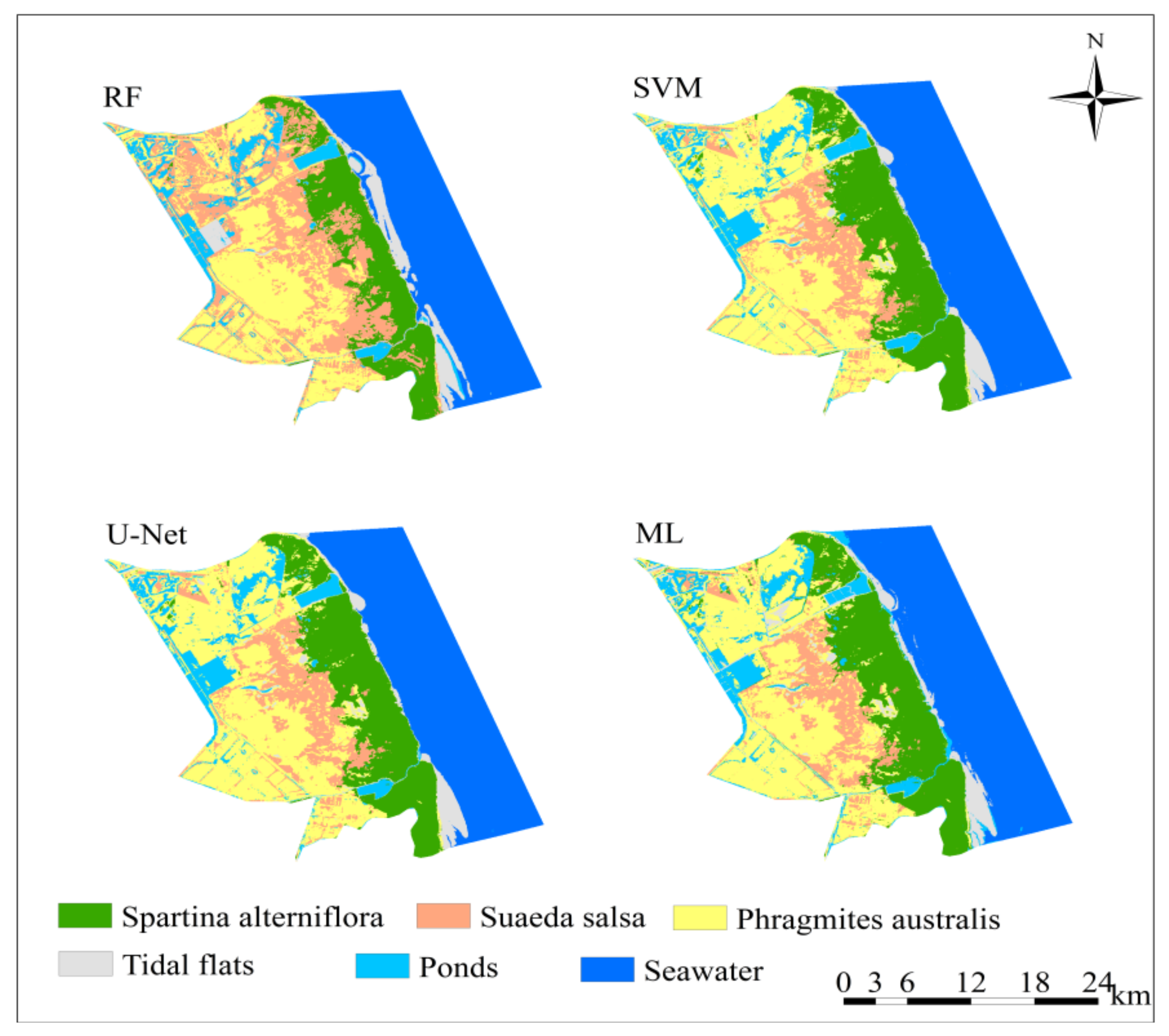

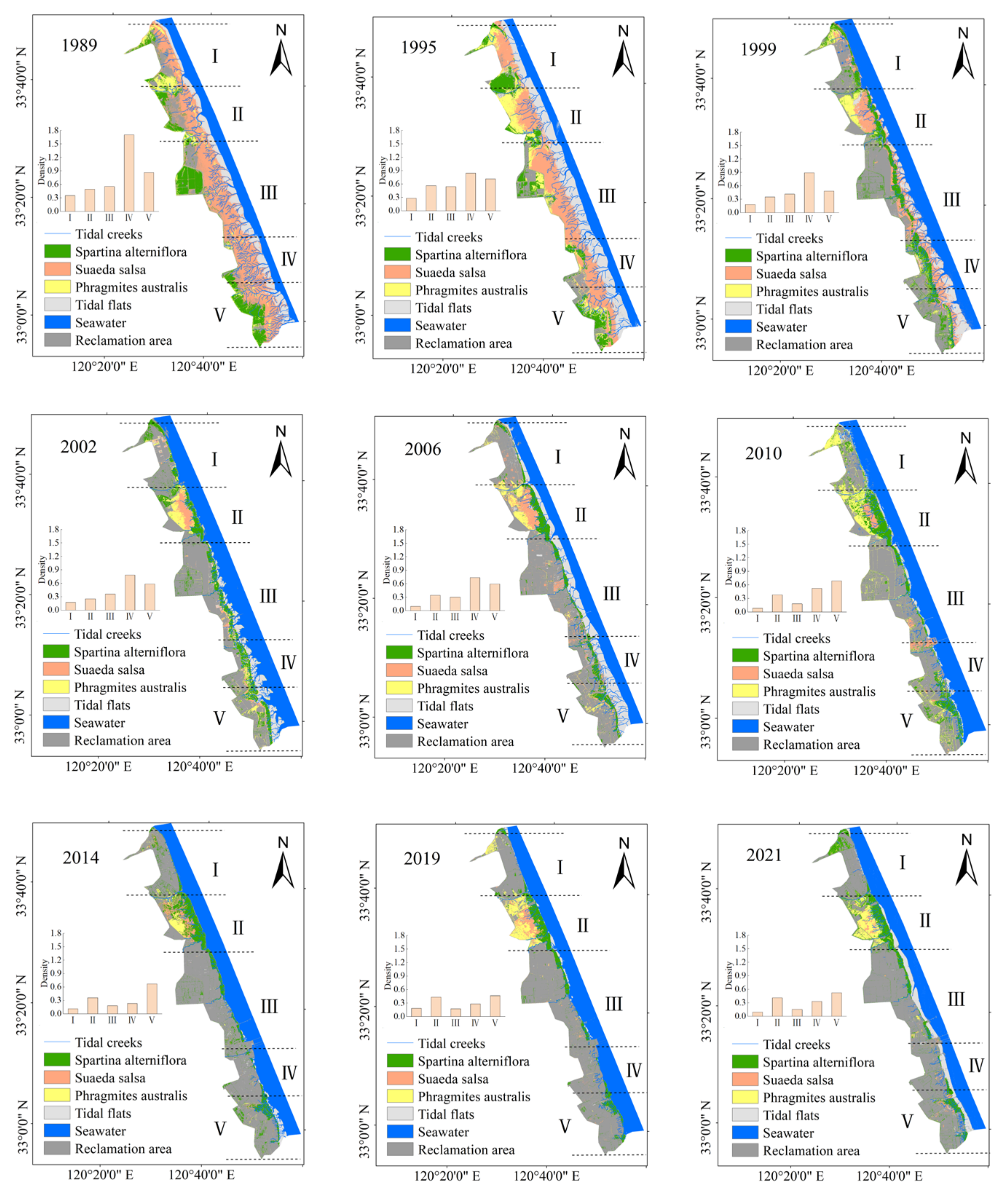

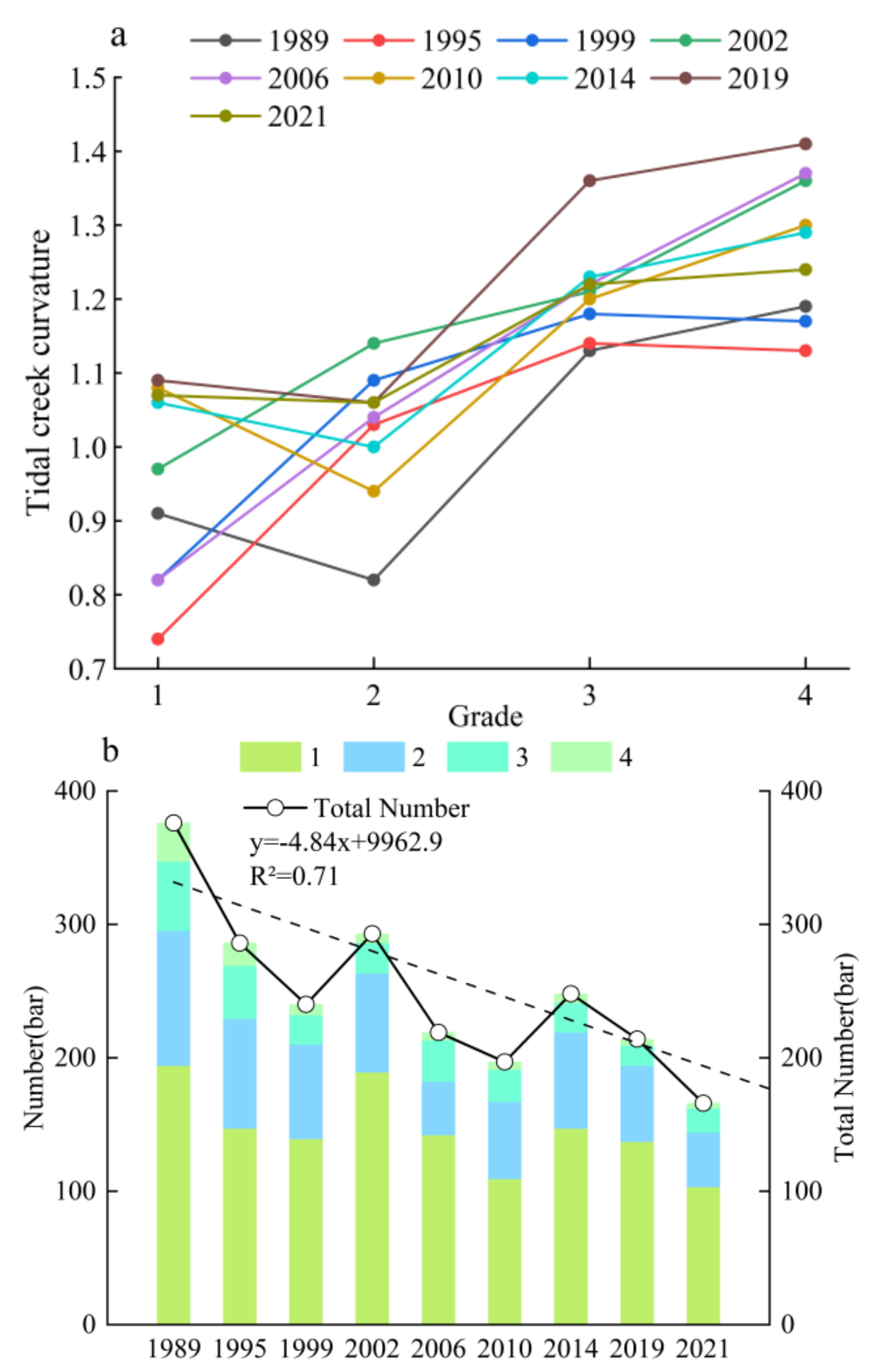
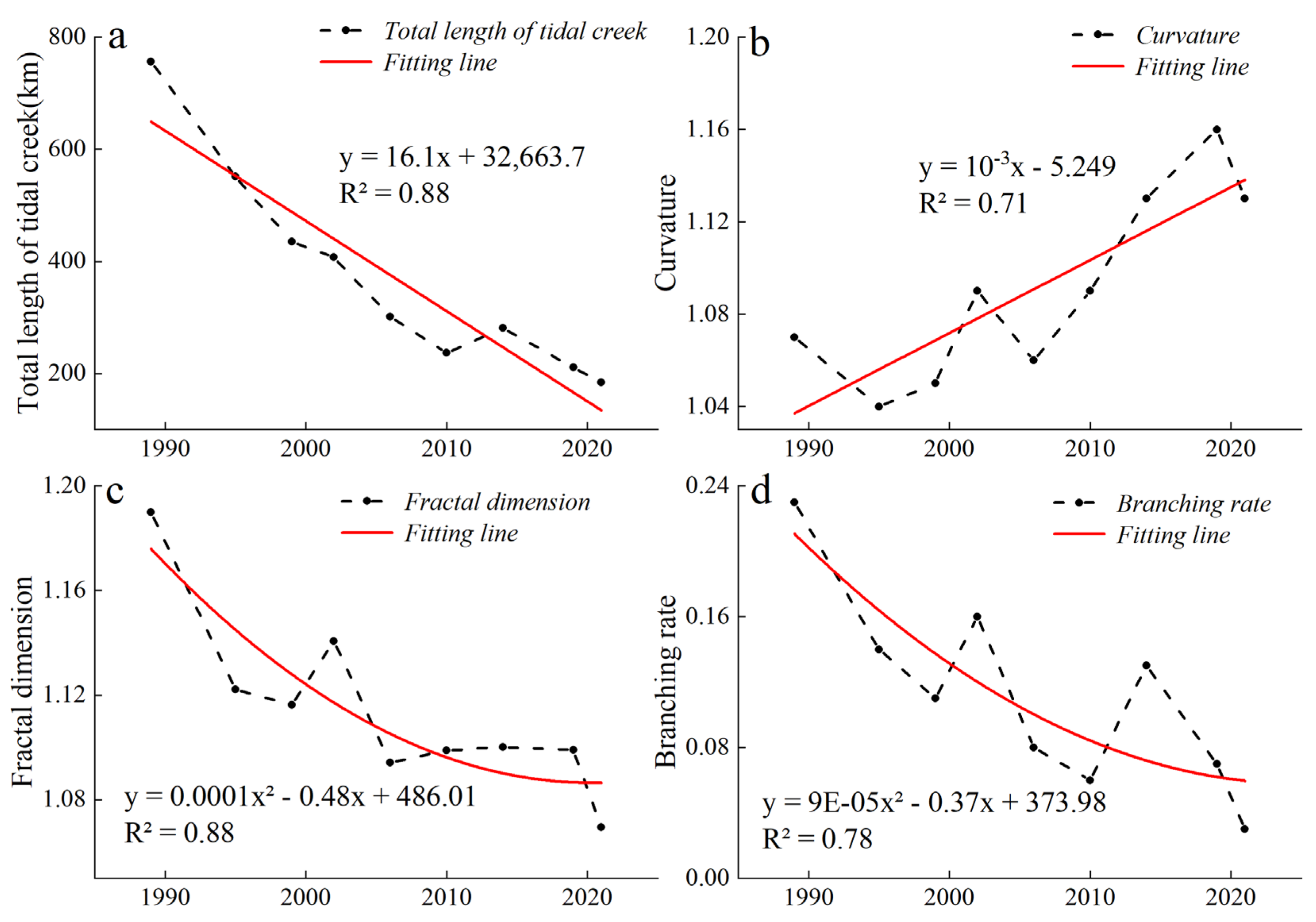
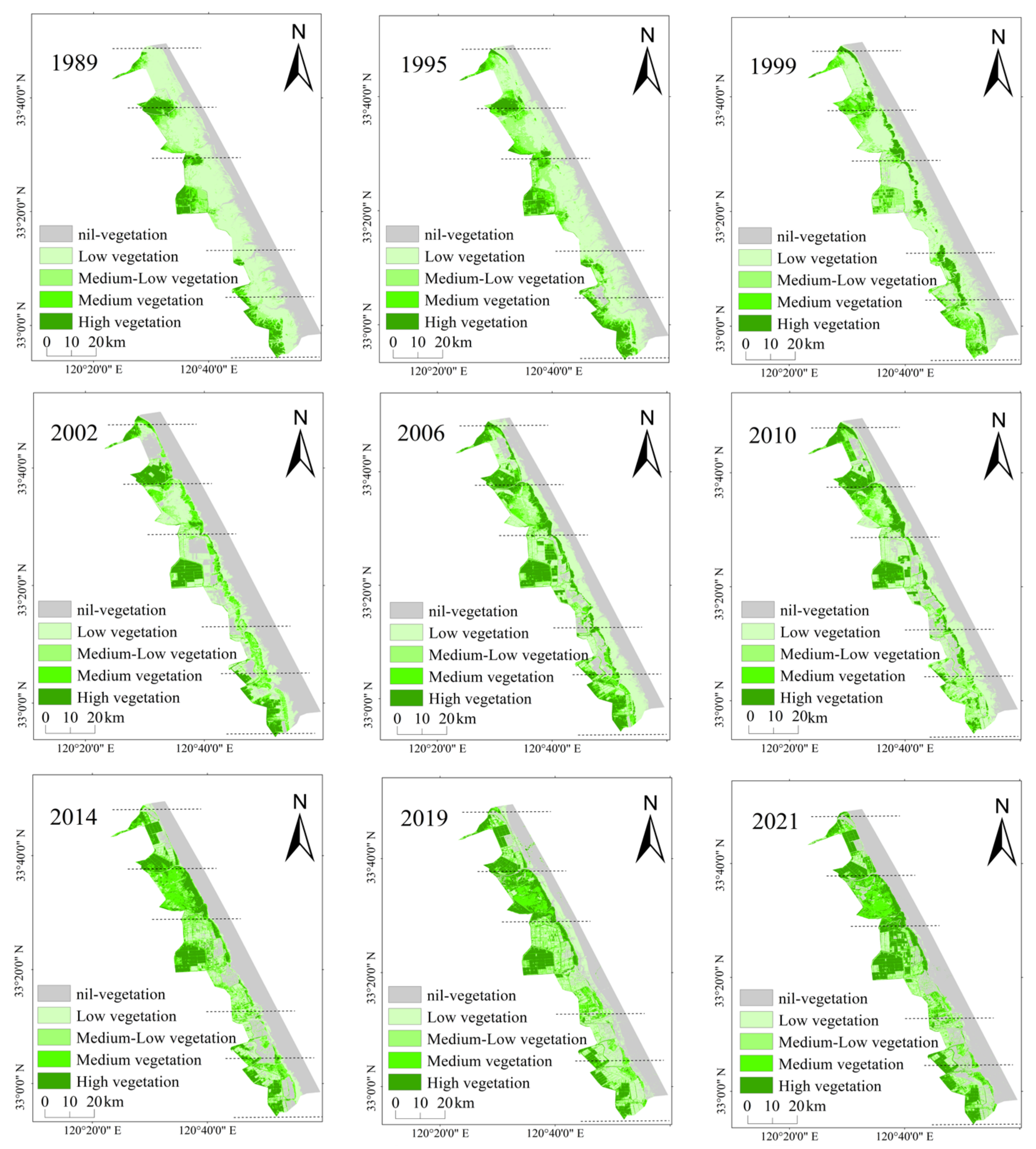
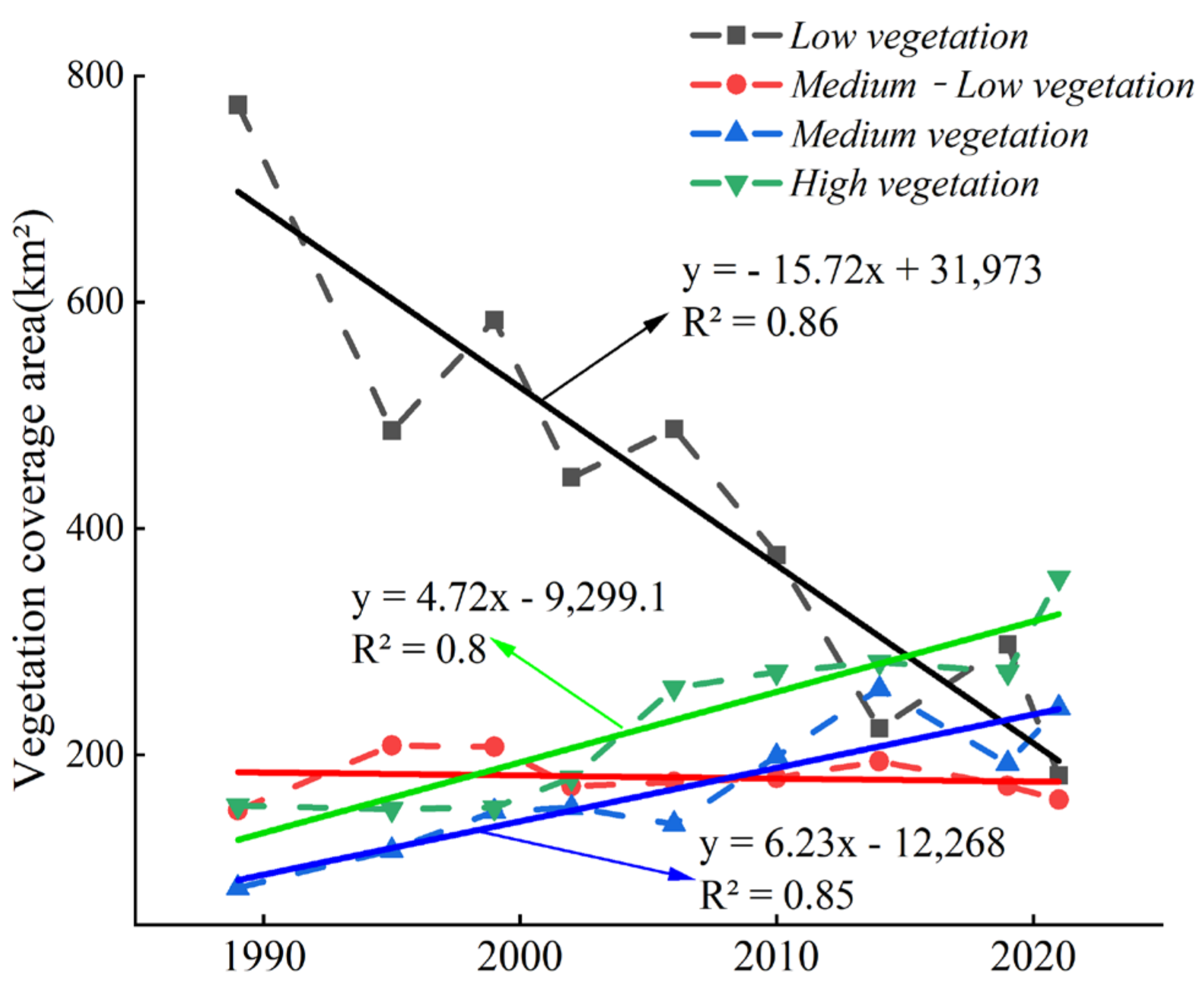

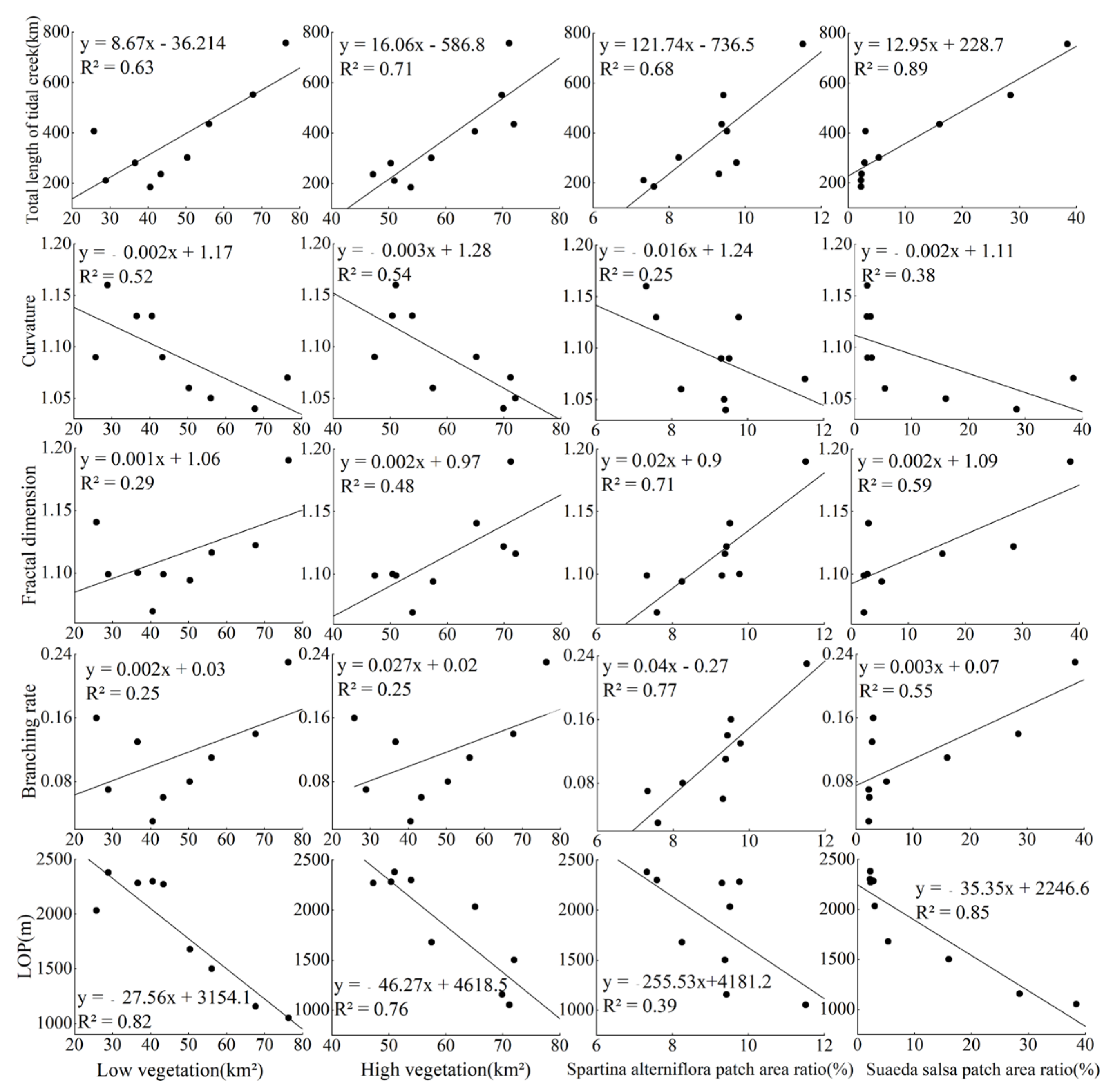
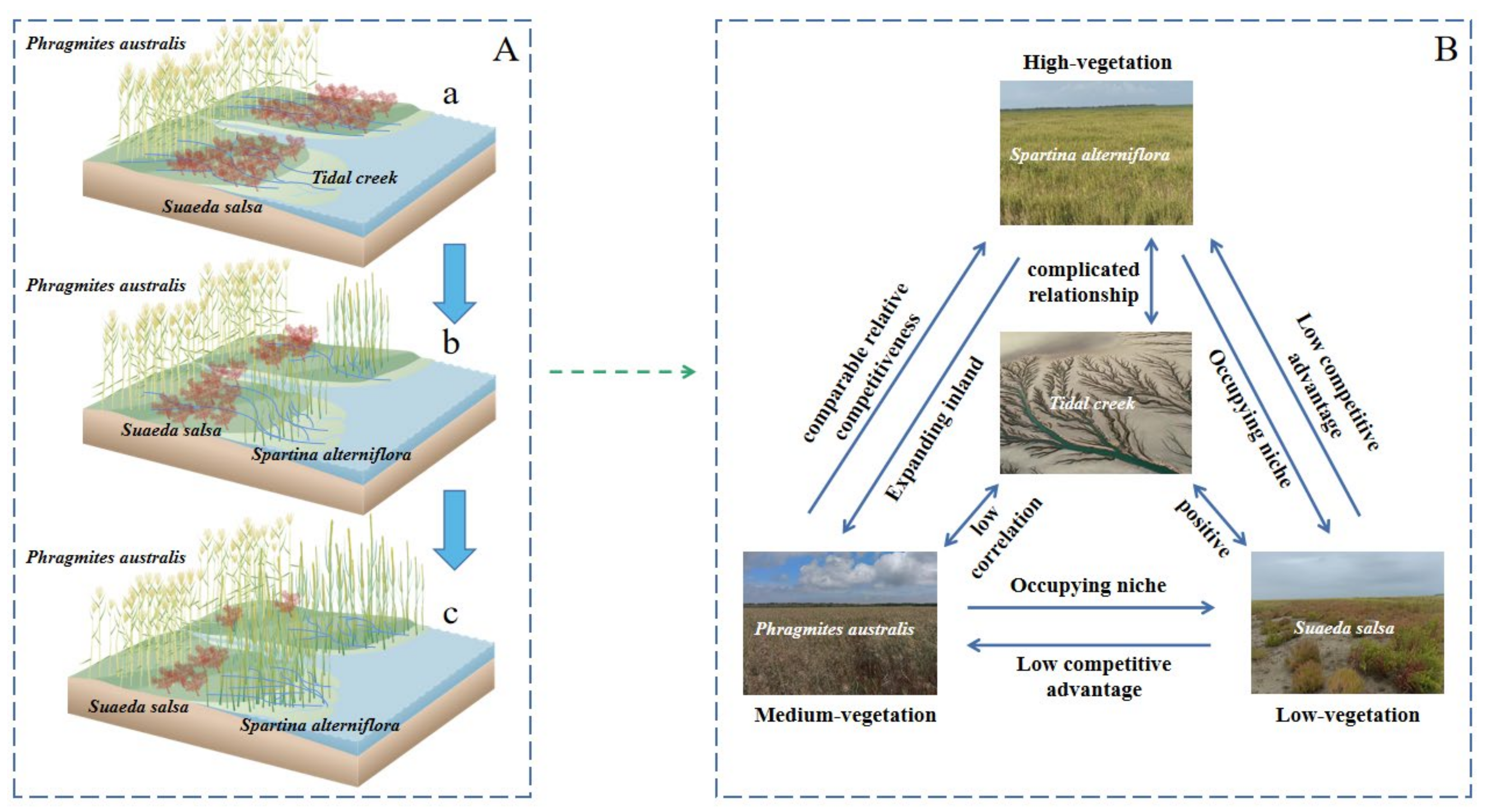
| Satellite | Time | Tidal Level/m | Resolution | Satellite | Time | Tidal Level/m | Resolution |
|---|---|---|---|---|---|---|---|
| Landsat5_TM | 2 August 1989 1:57 | 2.19 | 30 m | Landsat7_ETM | 9 August 2006 2:20 | 2.13 | 30 m |
| Landsat5_TM | 21 October 1989 1:55 | 1.71 | 30 m | Landsat7_ETM | 13 March 2010 2:23 | 2.77 | 30 m |
| SPOT-1 | 30 November 1989 | 1.34 | 20 m | Landsat7_ETM | 20 August 2010 2:23 | 1.87 | 30 m |
| Landsat5_TM | 23 January 1995 1:43 | 2.31 | 30 m | SPOT-4 | 17 September 2010 | 2.16 | 20 m |
| Landsat5_TM | 3 August 1995 1:34 | 2.18 | 30 m | Landsat8_OLI | 17 March 2014 2:31 | 2.36 | 30 m |
| Landsat5_TM | 19 February 1999 2:10 | 1.45 | 30 m | Landsat8_OLI | 26 October 2014 2:31 | 3.08 | 30 m |
| SPOT-4 | 27 May 1999 | 1.34 | 20 m | Landsat8_OLI | 21 August 2019 2:30 | 3.50 | 30 m |
| Landsat5_TM | 2 November 1999 2:06 | 1.62 | 30 m | Sentinel-2 | 28 September 2019 | 2.87 | 10 m |
| SPOT-4 | 17 August 2002 | 2.78 | 20 m | Landsat8_OLI | 9 November 2019 2:31 | 1.42 | 30 m |
| Landsat5_TM | 23 September 2002 2:04 | 3.45 | 30 m | Landsat8_OLI | 30 January 2021 2:30 | 2.67 | 30 m |
| Landsat7_ETM | 1 October 2002 2:18 | 2.05 | 30 m | Sentinel-2 | 30 August 2021 | 2.67 | 10 m |
| Landsat7_ETM | 20 March 2006 2:20 | 1.69 | 30 m | Landsat8_OLI | 29 October 2021 2:30 | 1.34 | 30 m |
| Method | F1 (%) | |||
|---|---|---|---|---|
| S. alterniflora | P. australis | S. salsa | Mean Value | |
| RF | 85.36 ± 0.39 | 89.05 ± 0.13 | 70.36 ± 0.13 | 81.59 ± 0.07 |
| U-Net | 94.53 ± 0.21 | 91.57 ± 0.08 | 90.87 ± 0.16 | 92.32 ± 0.12 |
| SVM | 93.87 ± 0.14 | 90.13 ± 0.15 | 89.18 ± 0.15 | 91.06 ± 0.08 |
| ML | 91.65 ± 0.36 | 88.77 ± 0.16 | 85.49 ± 0.22 | 88.64 ± 0.07 |
| 1989 (km²) | 2021 (km²) | Transfer Out (%) | Transfer Out Contribution Rate (%) | ||||
|---|---|---|---|---|---|---|---|
| NV | LV | MLV | MV | HV | |||
| No vegetation (NV) | 723.28 | 25.82 | 12.69 | 16.02 | 9.09 | 8.08 | 4.3 |
| Low vegetation (LV) | 388.68 | 201.86 | 167.71 | 240.55 | 235.86 | 83.65 | 69.85 |
| Medium–low vegetation (MLV) | 18.41 | 36.91 | 39.53 | 61.84 | 84.4 | 83.6 | 13.63 |
| Medium vegetation (MV) | 3.57 | 10.89 | 15.27 | 31.21 | 71.2 | 76.38 | 6.83 |
| High vegetation (HV) | 5.42 | 15.47 | 21.47 | 37.31 | 167.97 | 32.17 | 5.39 |
| Transfer in (%) | 36.52 | 30.62 | 84.59 | 91.93 | 70.45 | ||
| Transfer-in contribution rate (%) | 28.14 | 6.02 | 14.69 | 24.06 | 27.09 | 100 | |
Disclaimer/Publisher’s Note: The statements, opinions and data contained in all publications are solely those of the individual author(s) and contributor(s) and not of MDPI and/or the editor(s). MDPI and/or the editor(s) disclaim responsibility for any injury to people or property resulting from any ideas, methods, instructions or products referred to in the content. |
© 2023 by the authors. Licensee MDPI, Basel, Switzerland. This article is an open access article distributed under the terms and conditions of the Creative Commons Attribution (CC BY) license (https://creativecommons.org/licenses/by/4.0/).
Share and Cite
Zheng, G.; Wang, Y.; Zhao, C.; Dai, W.; Kattel, G.R.; Zhou, D. Quantitative Analysis of Tidal Creek Evolution and Vegetation Variation in Silting Muddy Flats on the Yellow Sea. Remote Sens. 2023, 15, 5107. https://doi.org/10.3390/rs15215107
Zheng G, Wang Y, Zhao C, Dai W, Kattel GR, Zhou D. Quantitative Analysis of Tidal Creek Evolution and Vegetation Variation in Silting Muddy Flats on the Yellow Sea. Remote Sensing. 2023; 15(21):5107. https://doi.org/10.3390/rs15215107
Chicago/Turabian StyleZheng, Guanghui, Yan Wang, Chengyi Zhao, Wen Dai, Giri Raj Kattel, and Dian Zhou. 2023. "Quantitative Analysis of Tidal Creek Evolution and Vegetation Variation in Silting Muddy Flats on the Yellow Sea" Remote Sensing 15, no. 21: 5107. https://doi.org/10.3390/rs15215107






